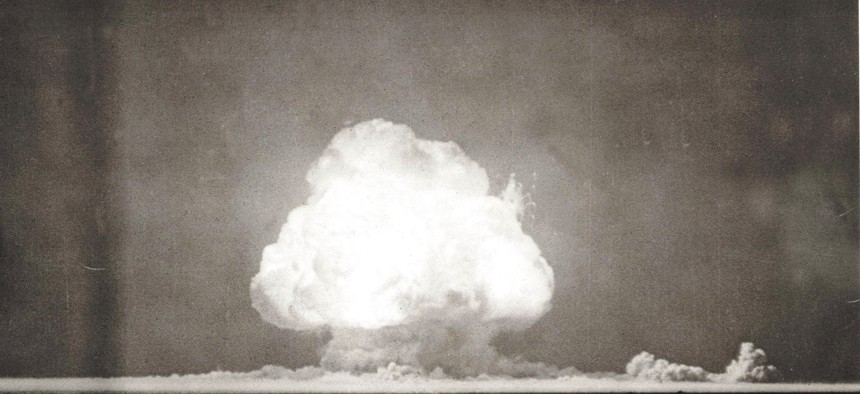
The world's first nuclear explosion on July 16, 1945, in New Mexico. U.S. Department of Energy
Happy Birthday to the Bomb
If we want to avoid nuclear destruction for the next 75 years, we must take the president’s finger off the button.
July 16, 1945, 5:30 a.m.: The first nuclear mushroom cloud rises with a blinding flash out of the New Mexico desert, 120 miles south of Albuquerque. The nuclear age is born. Just three weeks later, President Harry Truman would order the first bombs to be dropped on Hiroshima and Nagasaki, Japan, obliterating both cities and killing 200,000 people instantly.
And then…nothing. Even though the United States and Russia would race to build tens of thousands of nuclear weapons, costing trillions of dollars, the bomb—thankfully—has not been used in combat since. Why? A few good decisions and lots of luck.
One of Truman’s best calls, as we explore in our new book, The Button, was to take the decision to use the bomb away from the generals and keep it exclusively in civilian hands. Truman thought the idea of killing another 100,000 people “was too horrible.” This likely prevented the use of a third bomb, and possibly more. And yet, importantly, Truman also limited nuclear authority to just one civilian: himself. All U.S. presidents since have had the unilateral authority to start nuclear war.
Fast-forward to 2020. Most Americans are not aware and have not worried about sole authority—until now. President Donald Trump’s uneven temperament and abuses of power have brought renewed attention to this extremely dangerous executive perk. Yet Trump is not the first to inspire concerns about an unstable president with his finger on the button (Richard Nixon, during his last few months in office, was a heavy drinker) and there is no guarantee that a future president might not be even more reckless.
Trump’s presidency should compel us to consider questions that we too rarely ask: Why do we give presidents such power? Is it necessary? Or is it a left-over vestige of the Cold War?
It didn’t have to be this way. President John Kennedy wrote in 1962, “From the point of view of logic there was no reason why the President of the United States should have the decision on whether to use nuclear weapons. History had given him this power.” In fact, the case for sole authority is built on myths that should have been debunked long ago.
Myth No. 1: The U.S. must be ready to launch nuclear weapons within minutes. Since Truman, the rationale for sole authority has shifted from preventing nuclear use to accelerating it. A Russian nuclear missile attack could reach the United States in thirty minutes or less. We have lived under this theoretical threat of immediate destruction—an atomic Pearl Harbor—since the 1960s. But there is no reason to believe that such an attack is remotely likely or that a U.S. response must be immediate. In fact, both assumptions are dangerous and could force a president to make a catastrophically bad choice under crushing time pressures. If we want to avoid blundering into nuclear war, we need to give the president more time.
For example, U.S. land-based intercontinental ballistic missiles, or ICBMs, are highly vulnerable and, if not launched before a massive attack arrives, would likely be destroyed in their silos—but that does not justify launching them quickly. The U.S. would still have hundreds of nuclear weapons deployed on submarines hidden in the oceans and bombers that could be sent aloft. So, it would be suicidal for Moscow to launch the attack in the first place. Russian leaders may be ruthless, but they are not suicidal.
Moreover, it would be highly dangerous to launch ICBMs on warning of attack. The “attack” could be a false alarm, which have happened before (Sec. Perry experienced two false alarms while in office). If we launch nuclear weapons in response to a false alarm we have started nuclear war by mistake, the ultimate nightmare.
Myth No. 2: Presidents don’t make mistakes. Of course they do. All humans err. And when it comes to making quick decisions about nuclear war, the president would be working with incomplete information; could be emotionally unstable or under the influence of alcohol; or could be responding to a false alarm.
As President Ronald Reagan said about making nuclear launch decisions in the six minutes he expected to have, “everything would happen so fast that I wondered how much planning or reason could be applied in such a crisis.”
Myth No. 3: Nuclear weapons are not vulnerable to cyberattack. We tend to think about how cyberattacks would affect our computers, electricity grids, and communication systems. But in fact all of our networked systems, including nuclear weapons and their control systems, are vulnerable to cyberattacks. For example, imagine that an adversary hacks into the computers that warn the United States about possible nuclear attacks. We might “see” an incoming attack when none is there. Cyber threats dramatically increase the danger of accidental nuclear war.
To reduce these risks, the next president must change U.S. nuclear policy: he should end presidential sole authority, prohibit the first use of nuclear weapons, and phase out land-based missiles. ICBMs are not needed for deterrence but increase the risk of blundering into a nuclear catastrophe; they are an accident waiting to happen.
Despite dangerously irresponsible policies, we have managed to survive 75 years with the bomb. But we must see this for what it is—the result of luck, not logic. If we want to avoid nuclear destruction, we must take the president’s finger off the button. It is simply too dangerous to allow the president—any president—to control the fate of humanity.



